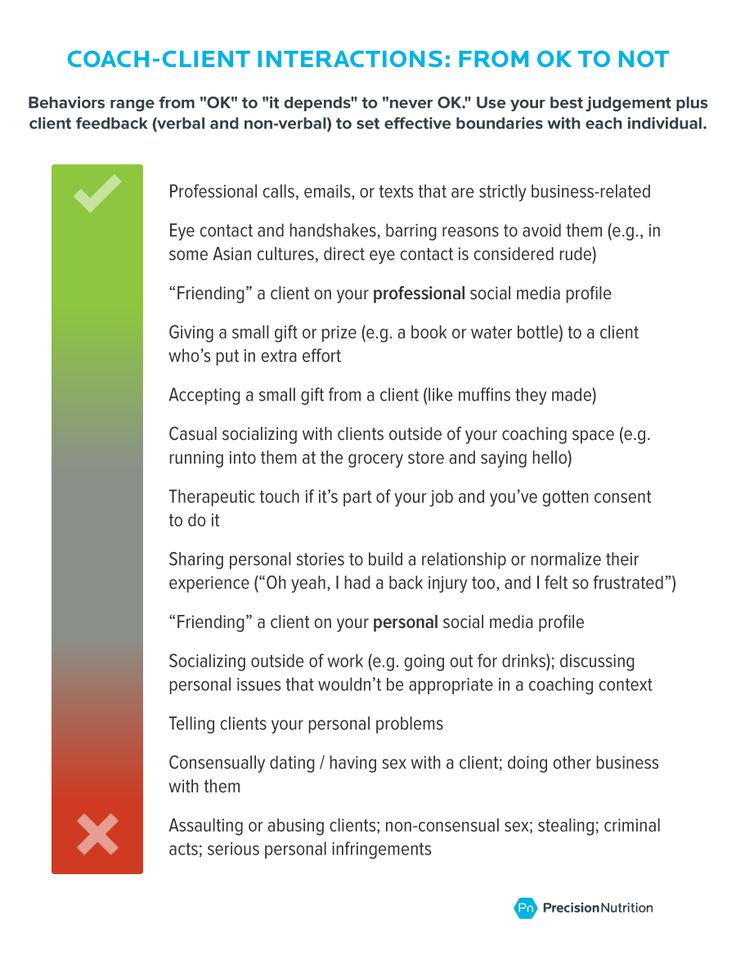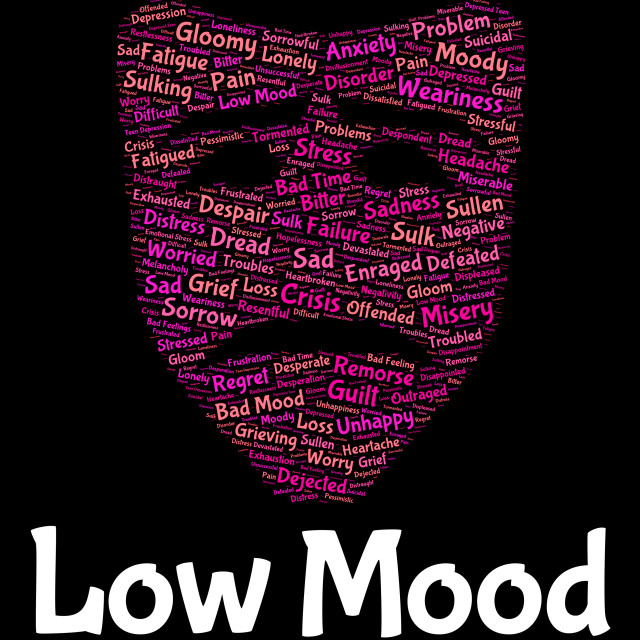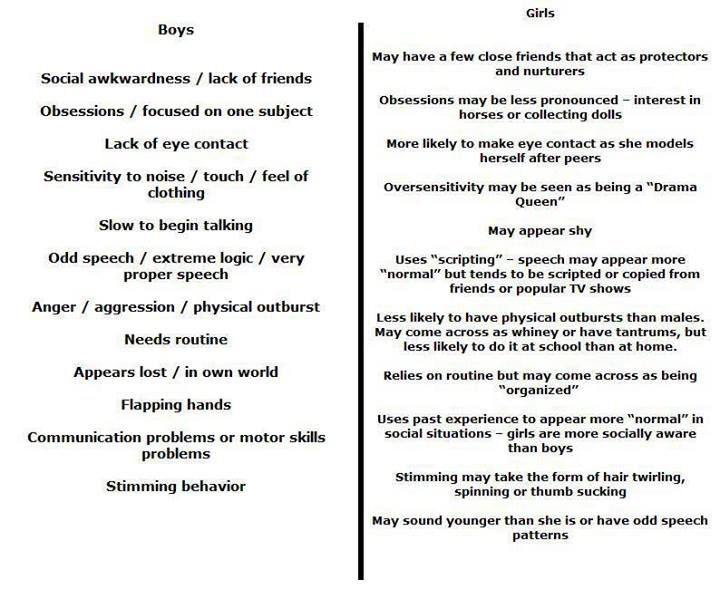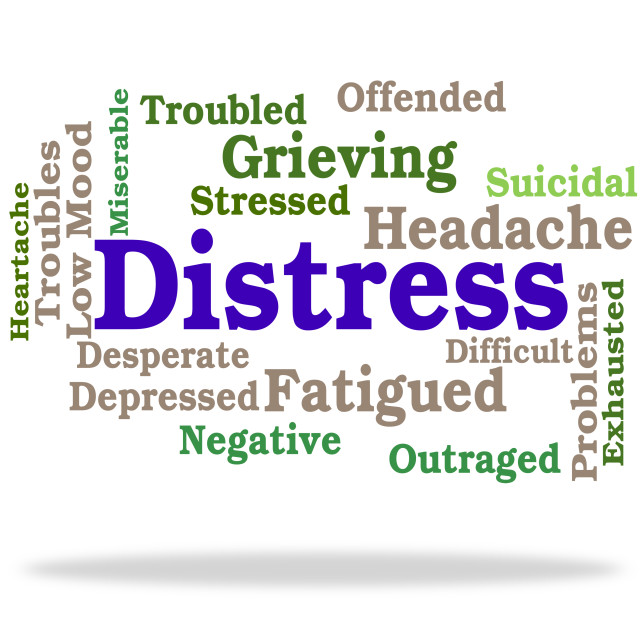How to establish boundaries in a relationship
The Healthy Relationship Boundary You Might Be Missing
Boundaries can help you retain a sense of identity and personal space, and they’re easier to create and maintain than you might think.
You’ll find boundaries in every kind of relationship — from friends and family to colleagues and brief acquaintances. You can’t see them, but these lines help you stay “you” and provide a sense of mutual respect, protection, expectations, and support.
While they’re important in all areas, boundaries come up a lot when it comes to romantic partnerships.
Spending so much time with — and investing significant amounts of emotional energy in — one person can sometimes cause those lines to blur, especially in those heady early days where excitement and aiming-to-please levels are high.
So what do boundaries in this type of relationship involve, and are there organic ways to re-seed them?
“When it comes to your life as a couple, consider that there are actually three entities involved: yourself, your partner, and the relationship itself — and boundaries need to be defined for each,” says Dr. Jacqui Gabb, professor of sociology and intimacy at The Open University and chief relationships officer with the couples app Paired.
“Each of those three parties needs to be sustained, nourished, and feel respected,” Gabb says.
Examples of healthy boundaries in relationships
The following examples apply to romantic partnerships, but also any frequently communicative relationships where there’s responsibility and expectation on both sides, like business partners, co-parents, or in-laws. In healthy relationships, both people:
- ask permission
- take one another’s feelings into account
- show gratitude
- are honest
- give space for autonomy and avoid codependence
- show respect for differences in opinion, perspective, and feelings
- sit with the other person’s communication of emotion
- take responsibility for their actions
Good relationship boundaries
While there are some basic rules to consider when building and maintaining healthy boundaries (as noted above), what works for one person might not be so ideal for someone else.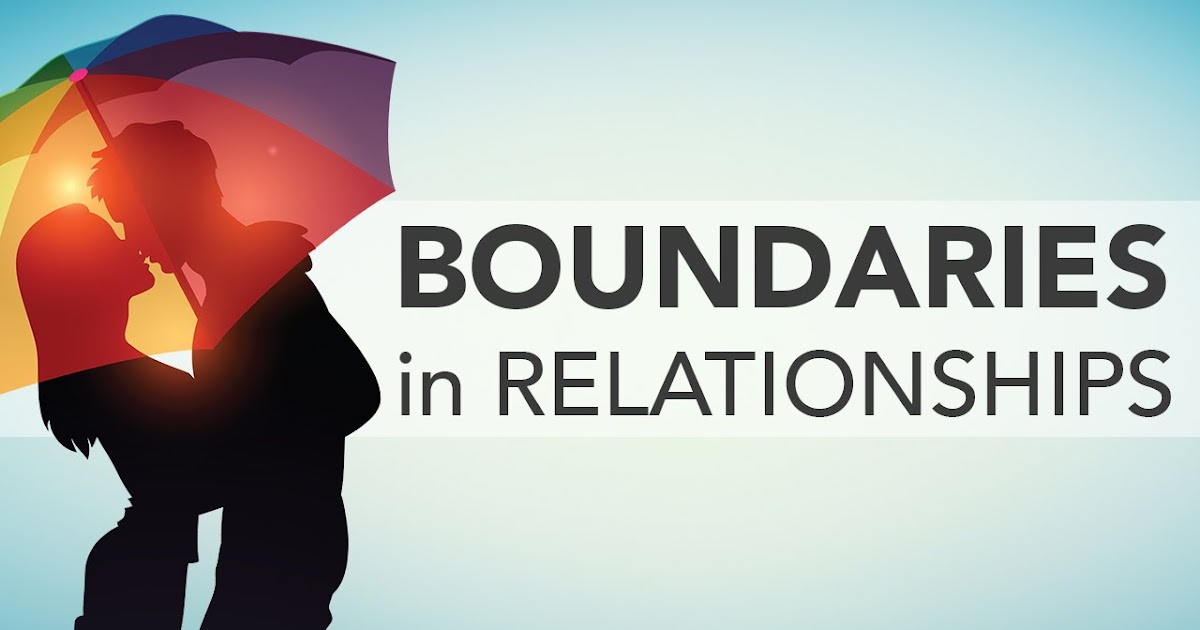
“Everyone’s got their own space and comfort levels when it comes to boundaries,” explains James Preece, dating coach and author of “The Five Rules Of Dating In The New Normal.” “It’s [about] respect, and showing them ‘I love you for who you are, and I’m going to give you the space you need.’”
It’s important to remember, he adds, that “before you find a partner, you’ve got your own patterns of behaviors that you become used to. Respecting people’s personal space is a very important boundary in itself.”
Boundaries come into play in all aspects of intimate relationships, though you may find they’re more important or require a bit more attention in some circumstances than in others.
Texting is a very common one, notes Preece, when one partner constantly checks in “because they’re worried the other person is going to lose interest in them.” Yet research from 2017 shows frequent texting can lead to lower perceived relationship quality, so this is an important area in which to set some boundaries.
The amount of time you spend together is another key one to consider, and this is likely to change throughout the relationship. Whereas you might set a boundary early on in the relationship around how many days you see each other, later on, you have to ask: “When do you become the priority? Are they always seeing their friends over seeing you?” says Preece.
Money is another notable relationship boundary, as are sex and relationship agreements. Gabb states, “Do you believe in monogamy? If so, what constitutes a breach of trust? If someone feels their partner is really flirtatious, and that causes them to feel threatened, that [boundary] needs renegotiating.”
Relationship woes? Our advice columnist wants to hear from you!
Submit your anonymous questions here for Sex, Love, and All of the Above from Psych Central sex and relationships writer Morgan Mandriota. Then subscribe to our weekly newsletter to find out if your question is featured.
While it’s a good idea to set some boundaries, some don’t work and can ultimately have a negative effect on one or both partners. These tend to be founded in control, when one person tries to restrict or command the actions of the other — and there are some definite red flags to look out for.
These tend to be founded in control, when one person tries to restrict or command the actions of the other — and there are some definite red flags to look out for.
“Anything that limits a person’s options” is an unhealthy boundary, Preece explains. “It could be around time, the way they act, even the way they dress.” Crossing these lines, he adds, “can be dangerous.”
This is something Gabb agrees with.
“We shouldn’t confuse boundaries and control —– they’re not the same thing,” she says. “If someone feels a partner is putting up boundaries in a controlling way — ‘These are my boundaries, and this is what you must do’ — then there’s a problem with communication around boundaries being established.”
Boundaries also shouldn’t be implemented to try and change a partner.
“It’s not about trying to manipulate the negative stuff,” Preece states. “Accept them for who they are. If they’re not right and you’re not compatible, set them free to meet someone else.”
There are a variety of different ways you can go about setting boundaries. Here are four approaches to get you started:
Here are four approaches to get you started:
Begin early
It’s much easier to introduce boundaries at the start of or earlier on in a relationship, rather than years down the road — especially once habits and routines have been established and both partners are more emotionally invested.
But if it’s a little late for that tip, don’t worry. Installing boundaries at any point is still better than imposing upon each other until it frays your bond completely.
Conversation is key
No matter how awkward you might feel talking about your emotions or bringing up trickier subjects, a two-way discussion is vital in boundary setting.
“Communication is key to relationships,” Gabb says, and “you do need to have [conversations], even if they’re really difficult things to talk about, like sex.”
Not only do these discussions help both partners understand the extent and rules of the boundary, but they provide an opportunity to explain why you value a particular boundary.
Plus, 2016 research suggests that couples who check in regularly and open up experience greater relationship satisfaction overall.
These conversations can also help nip concerns in the bud before they boil over into a full-blown argument.
They don’t need to happen every week, either, notes Gabb: “The important thing is that you’re communicating with each other and recognizing when you need to have that conversation.”
Use ‘I’ statementsAs the old saying goes, it’s not what you say but how you say it — and this definitely applies to boundaries.
“I think all communication should start with ‘I feel,’” Gabb states. If you lead with superlative or accusatory statements (like “you always” or “you never”), then “you’re going to be hit with a brick wall of ‘That’s not what I think.’”
“Nobody wants to be criticized or rejected,” adds Preece.
And once those defensive barriers come up, it can be hard to get the conversation back on track.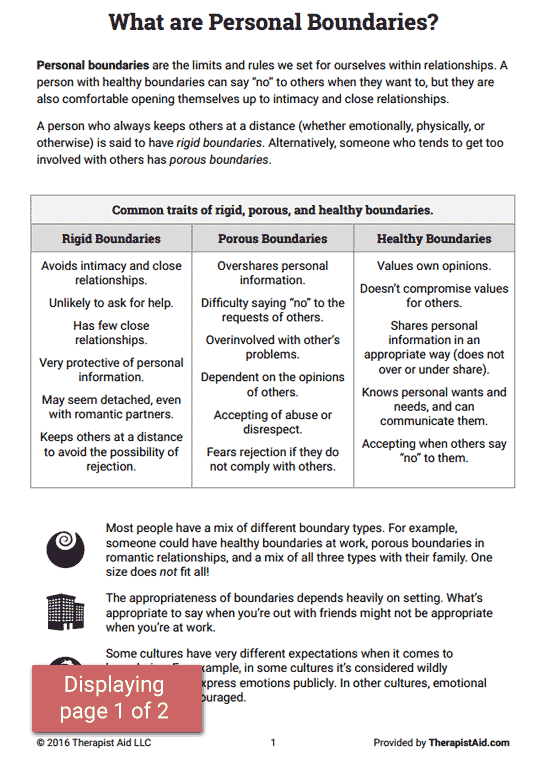 Treat others how you like to be treated, so aim to set boundaries with kindness.
Treat others how you like to be treated, so aim to set boundaries with kindness.
Giving more specific examples can also help support your point and make it seem less of an overarching attack.
Examples of ‘I’ statements done the right way
- I felt really ____ when this happened
- I feel ___ when you
- If feel like ___
‘I’ statements done incorrectly
- I know that you ___
- You made me ___
- You always ___ to me or at me
It’s OK to ask for space
Whether you’re just starting out with a partner or have been with them for a while, it’s totally acceptable to desire —and ask for — some me time.
“It might be that you have a really demanding job, and you need half an hour of debrief time when you come home where you don’t talk,” Gabb says. “It’s about ‘This is what I need, how can we make it happen?’”
There’s a chance your partner might see this request as a form of rejection, so it’s important to take their feelings into account and explain this isn’t the case.
“Talk about why you need it and why it’s meaningful to you,” suggests Gabb. “Recognize how the other person may feel, and work with them [through] that.”
Having boundaries is an expected and healthy aspect of good relationships — so don’t be afraid to determine where they lie for yourself, for your partner, and as a couple.
Think of them as a framework rather than rigid guidelines.
“Nothing is set in stone. Everything is flexible, and every relationship is different,” Preece says — although it’s always important to remember you should “never do anything just to please someone else. Only do things you want to when you’re ready.”
Events can occur throughout your relationship that’ll cause boundaries to shift, notes Gabb, including:
- having children
- moving home
- starting a new job
- experiencing a loss
Ultimately, says Preece, it all comes down to how you handle these changes together: “You deal with it because you’re a team, and you respect each other’s side. ”
”
Criticism in Relationships: Examples and Effects
Again and again in my work with couples I see the destructive effect criticism can have on a relationship. In this article I would like to explore what my three favorite relationship experts have to say about criticism and its effects on relationships.
Drs. John & Julie Gottman
The therapists who have done the most research on the effects of criticism on relationships were undoubtedly Drs. John and Julie Gottman. The two are famous for their “love lab,” in which hundreds of couples were screened, interviewed and observed over the course of two decades. As a result of their research the Gottmans could predict in less than five minutes, with 90 percent accuracy, if a couple was going to stay together or divorce.
They came up with a metaphor to describe four communication styles that can predict the end of a relationship. They termed them “The Four Horsemen” — a phrase coined after the Four Horsemen of the Apocalypse from the New Testament, depicting the end of time.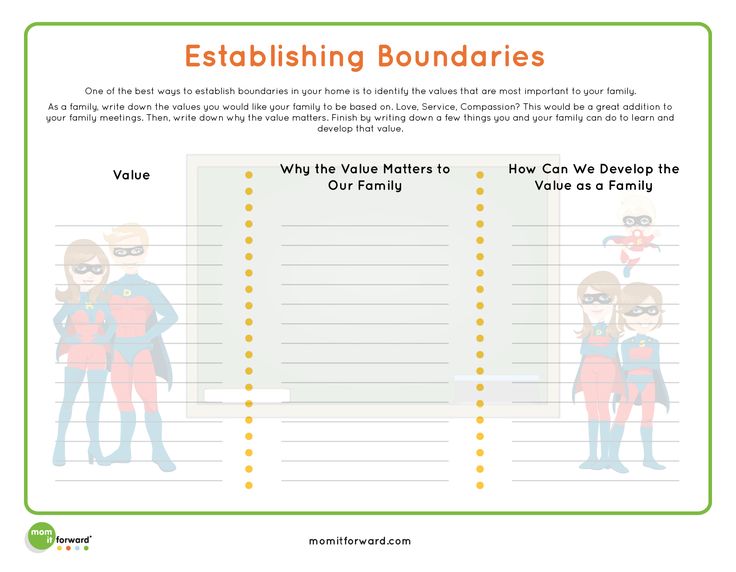
- Criticism
- Contempt
- Defensiveness
- Stonewalling
For the purposes of this article I will only be focusing on the first and second of these “horsemen.”
Criticizing your partner is different than offering a critique or voicing a complaint. Critiques and complaints tend to be about specific issues, whereas criticism has to do with attacking your partner’s character and who they are.
For example, a complaint might be: “We haven’t gone on vacation together in so long! I’m tired of hearing about our money troubles!” Here we see a specific issue being addressed that is a problem for one partner.
A criticism might go something like this: “You never want to spend money on us! It’s your fault we can never go away together because you spend all our money on useless things!” This is an outright attack on the partner’s character. It is guaranteed to put them in defensive mode and sets the tone for war.
The main problem with criticism is that it can pave the way for the worst of the horsemen — contempt.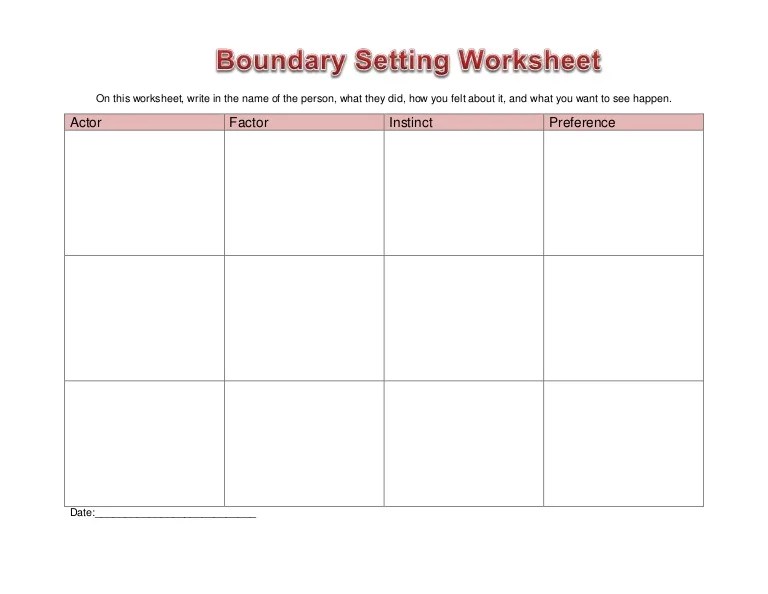
Contempt is about holding your partner in a negative light without giving them the benefit of the doubt. The contemptuous partner is usually attacking from a place of superiority. This can send their partner the message that they are not liked, appreciated, understood or respected. This does little to create a safe, secure and trusting bond in the relationship. The tragedy is that when parents model this negative type of bonding it creates an enormous amount of insecurity and anxiety for their children.
Treating your partner with contempt is the single greatest predictor of divorce, according to Dr. Gottman’s work. It is by far the most destructive of the four communication styles.
Stan Tatkin
Stan Tatkin, who created a psychobiological approach to couples therapy (known as PACT), is another well-known clinical expert and researcher on couples. He describes in great detail how the brain can be wired for both war and love but points out that our brains are not necessarily that good at this thing called love:
“The brain’s wired first and foremost for war rather than love.
Its primary function is to ensure we survive as individuals and as a species and it is very, very good at this.” (1)
Tatkin talks about the importance for couples to foster the “couple bubble” in order to counteract this tendency toward war. This is the intimate world of the relationship where you and your partner let each other know that the relationship is a secure and safe haven. It gives the message that your partner can be your go-to person under stress or duress, that your partner has your back, cares about you and will protect you. Couples that know how to foster a “couple bubble” will have a relationship that truly thrives.
Contempt and relentless criticism put a couple at war with each other. This is the opposite of the couple bubble. Smart partners who want to create a strong and happy relationship need to do all that they can to preserve and foster a strong couple bubble.
Emotionally Focused Therapy (EFT)
EFT was created by Sue Johnson, who Dr. Gottman called “the best couples therapist in the world.” In this model, criticism is seen as part of what’s called “the negative cycle.” The negative cycle is an interaction cycle between two people that, when left unchecked, can create an enormous amount of distance and disconnection in a relationship.
Gottman called “the best couples therapist in the world.” In this model, criticism is seen as part of what’s called “the negative cycle.” The negative cycle is an interaction cycle between two people that, when left unchecked, can create an enormous amount of distance and disconnection in a relationship.
In the EFT approach the focus would be on what the emotion is that underlies and fuels the criticism. The underlying feeling is what needs to be addressed in order to defuse the negative cycle. The goal of EFT is to get to the softer, more vulnerable feelings underlying the negative cycle.
In Stan Tatkin’s language, the goal would be to access the loving brain underneath the warring brain. In order to access the softer underbelly of sometimes vicious fights, it is important to create an emotionally safe environment for exploration. In the beginning, this is often most of what I am doing with my couples: creating an emotionally safe space to explore the feelings that underlie their negative and reactive cycles.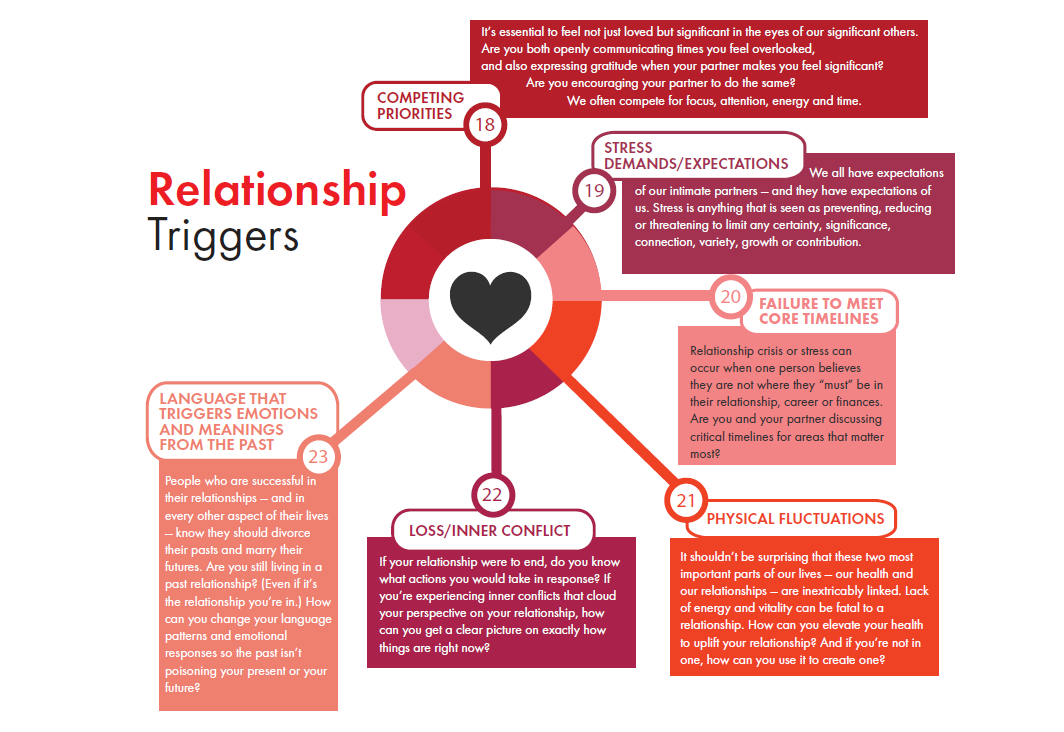 Naming the more tender and vulnerable feelings underneath the negative cycle is the first step out of it.
Naming the more tender and vulnerable feelings underneath the negative cycle is the first step out of it.
George and Beth
One of my couples came in exhausted from their endless, circular fighting. Their negative cycle went something like this: George would get critical and Beth would become defensive. Then, in order to get his point across, George would become more critical, which just made Beth more defensive. Around and around they would go on their not-so-merry-go-round.
What finally broke their negative cycle was when George started to access what was going on for him just before he started to become critical. He saw Beth as someone who had a lot of things going on all the time, and he didn’t feel like that much of a priority to her, which felt hurtful. Instead of letting Beth know how important she was to him and how much he missed quality time together, he would attack her with criticisms. This way he would get her attention but in a very negative way.
Unfortunately, this is exactly what his parents had modeled for him. When Beth was able to witness the hurt that lay under his critical attacks, she was able to come forward and offer reassurance about her love for him. George, secure in Beth’s love for him, became far less critical and better at asking for what he really needed. This couple was well on their way to repairing their relationship and creating a strong couple bubble.
All relationships have some conflict and disappointments. This is actually healthy. Conflicts and disappointments don’t have to destroy a relationship. It is how the couple handles them that matters.
Couples who can avoid the four horsemen and come together skillfully (à la the Gottmans), couples who can access their loving brain versus their warring brain even under duress (à la Dr. Tatkin), and couples who can speak to the vulnerability that underlies their reactivity (à la EFT) are all couples who will thrive, even under stressful circumstances.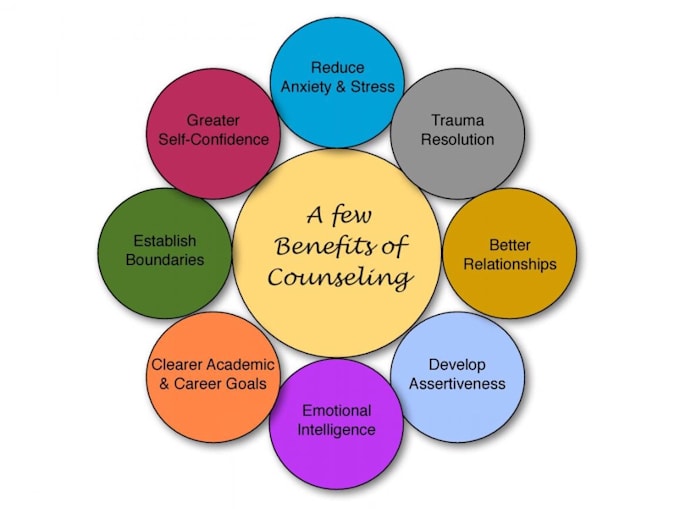
Reference Tatkin, Stan. Wired for Love. 2006: Three Rivers Press.
I'm in the house: how to set boundaries correctly
Personal boundaries are a line that runs between individuals, the people around them and larger social systems. They are needed so that we can clearly feel: where I am, and where I am not; where are my own emotions, actions, beliefs and thoughts, and where are others. And if these emotions and thoughts are mine, then I am responsible for them and control them. Borders also protect our inner world from outside encroachment.
They may look like a five-meter stone fence with barbed wire and machine gunners on the towers. Or they may be absent altogether - all the doors will be wide open. Boundaries can change depending on the context and environment, become solid for some people and completely blurred for others.
Personal boundaries can be opened for "import", when we gladly accept other people's help, resources, time, money, etc.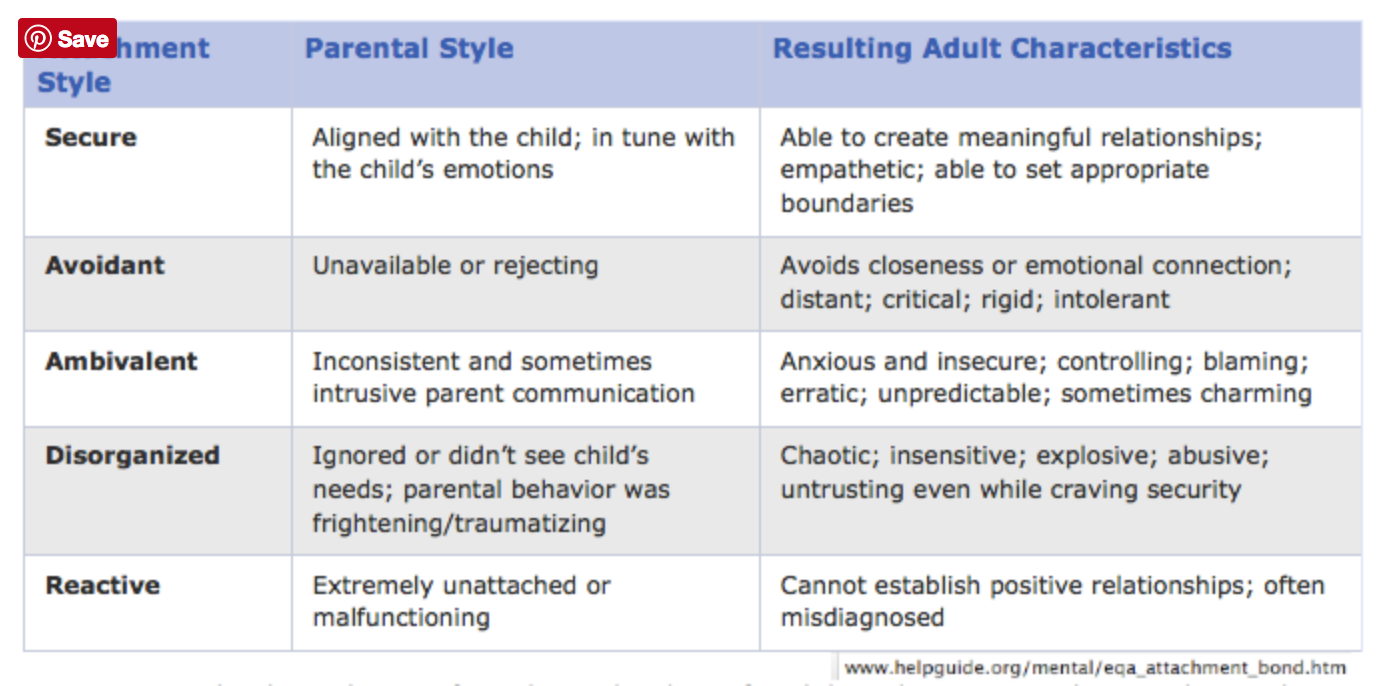 , or for "export" - our own resources. We usually import what we especially need, and we export either what we have in abundance, or what we hope to get a good price for.
, or for "export" - our own resources. We usually import what we especially need, and we export either what we have in abundance, or what we hope to get a good price for.
Borders are needed to mark two important questions:
1. What do I consider my property (and, accordingly, I will protect)?
2. What am I responsible for (and will try to control)?
Boundary checking
How does this manifest itself in specific behavior? There are people for whom property boundaries can be very arbitrary. Such a person does not consider anything his own, inviolable, he "does not become attached to things." He cannot close himself in his room because he considers it impolite. Such people cannot refuse help or money, even realizing that this money will not come back. Their borders are always open for imports, it is important for them that people see them as kind, generous and open. It's a way to build relationships. Sometimes they even think that having nothing of their own is safer.
It's a way to build relationships. Sometimes they even think that having nothing of their own is safer.
The opposite type is people whose boundaries are too wide. They consider everything their property - wife, children, employees, office or apartment space, other people's things and time. They do not see other people's boundaries and do not consider it necessary to observe them. Wherever such a person is, there is always “too much” of him, he captures the space around him. And if he was not given something in a good way, he can take it away "in a bad way."
Two "extreme" types also exist in relation to responsibility. There are people who take on too much, trying to control what is beyond their control. Such a wife thinks that her husband yelled at her because she did not have time to set the table on time or did not clean up well enough. People agree with every charge brought against them. The logic is this: if I tried better (guessed other people's desires and did everything right), then this would magically change those around me, make them happy and loving. People with such a strategy of thinking lack recognition and praise, they are ready to do everything to get this simple currency.
People with such a strategy of thinking lack recognition and praise, they are ready to do everything to get this simple currency.
The other extreme is characters who are not ready to take responsibility not only for others, but also for themselves. They do not see their contribution to the development of conflict situations, do not accept criticism and try to avoid any obligations. If you entrust them with a project, they will either require a partner or will come running every half hour with questions and clarifications so that the responsibility does not lie with them (or at least not with them alone). Men with a fear of responsibility are almost elusive for marital or paternal obligations. They consider them a violation of their boundaries, because the family will force them to change their usual way of life.
Border Guard Day
How to define your borders and protect them? Unfortunately, you cannot put up pegs and notify others that “this half a meter of land around me is my territory, do not enter without knocking. ” Although, in fact, this is exactly what young ladies with long puffy skirts did in the old days.
” Although, in fact, this is exactly what young ladies with long puffy skirts did in the old days.
In my trainings I often do a simple exercise. I ask a person to designate a limit invisible to others, and I begin to slowly approach it - step by step. The task of the participant is to make it clear without words that I am already close to the point that I do not need to cross. The reaction is very different. Someone is very calm at first and only at the last moment begins to frown. Someone, on the contrary, from my first step “gets into a pose” and puts on “boxing gloves”. Very polite people let me close, with a bewildered smile on their face. And only then it turns out that I have long passed the intended border. There was also such an “intelligent” reaction: when a person understands that I am not going to stop and provoke him to more obvious actions, he himself takes a step back, leaving his integrity stable. But in order to stay at a safe distance from me, he has to give up his territory.
I don't know how you would react in this exercise. Think about it.
You can defend your borders in different ways in different situations. The ability to say "no" (without the subsequent sprinkling of ashes on the head!) Is an important personality skill. It is necessary for those who easily succumb to pressure, aggression and other "honest ways of taking money."
The ability to create and protect one's own boundaries, of course, is formed even by parents. But over the course of life (and with different people), boundaries can change many times. Teenagers, for example, protect them militantly, they need this life period in order to separate from their parents and learn to build their own lives on their own, to respect themselves. And couples in love sometimes completely dissolve in each other, and only then they begin to notice that it has become crowded. If you do not revise the rules of interaction in time, do not outline the circle of your interests, then the couple comes to a crisis or even breaks up.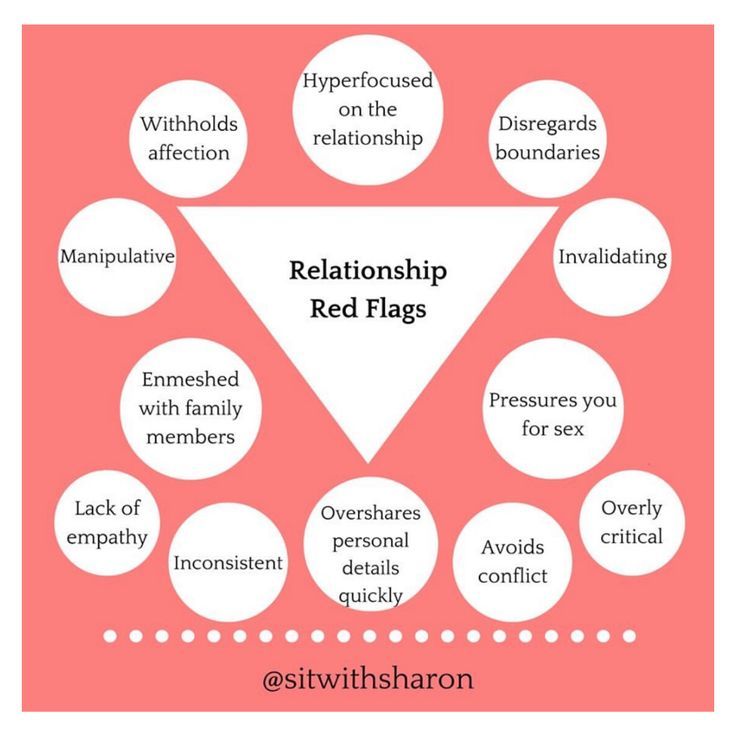
Like any other skill, the ability to see and respect one's own and others' boundaries may well be mastered at a later period of time.
How to defend your territory
How do you react to a yelling boss? Do you get nervous before public speaking? Are you able to refuse requests from loved ones if they are inconvenient for you? Do children have the right to disagree with you, to close in their room? How do you feel when your spouse (or best friend) said something “wrong”? Do you want to suggest, correct, give a cuff, shame, do you think that the actions of loved ones “dishonor your reputation”?
The skill of respecting other people's boundaries is, first of all, allowing other people to be different from you. A good aphorism caught my eye recently: “Selfishness is not when you do what you want. This is when you are sure that others should do what YOU want. When you want to "do good" to someone - that is, to help, give advice, stand up for someone, correct the situation - pause and look around. Does this violate someone's interests, does it plunge your counterpart into a position of helplessness and dependence? Have you been asked for this help? Does the person really need this kind of help?
When you want to "do good" to someone - that is, to help, give advice, stand up for someone, correct the situation - pause and look around. Does this violate someone's interests, does it plunge your counterpart into a position of helplessness and dependence? Have you been asked for this help? Does the person really need this kind of help?
The main feature of "healthy" boundaries is their flexibility.
If you know how to move away from situations that are dangerous or unpleasant for you (if not physically, then at least emotionally!),
If you can, depending on the situation, open up to "import" and "export" of resources, adequately use the words “yes” and “no”,
if you find it comfortable and safe to get close to the people you choose,
if you are able to consider both your own interests and the interests of others,
then your relationships with people become much more simple, honest and pleasant.
How to set and maintain personal boundaries
When was the last time you said no? Did you feel remorse, guilt, or deep regret that you could upset someone with your rejection? If yes, you are not alone - the vast majority of people experience similar emotions in such situations. To stop feeling guilty at those moments when we make a choice in favor of ourselves, and not others, we re-read the book by Jenny Miller and Victoria Lambert “Personal Boundaries. How to install and defend them.
Victoria Lambert, Jenny Miller
Mann, Ivanov & Ferber, 2018
Why personal boundaries are needed our actions and words. However, the main purpose of personal boundaries is to defend your interests and prevent unnecessary discomfort. Moreover, this applies not only to annoying people who strive to get into your soul, but also to various limiting beliefs, living conditions or habits. Healthy boundaries are needed in absolutely everything - and first of all, in order to feel good.

However, sometimes in an attempt to protect ourselves, we may overreact to stimuli or get lost when we need to, on the contrary, resist the onslaught
In such situations, instead of protecting ourselves, we think about whether we have offended another whether they reacted correctly, how they formulated the thought, and further down the list ... But any violation of boundaries is not only a conflict between you and the outside world, but also an intrapersonal mini-quarrel. The body gives a signal of danger, and you decide how to respond to it. It happens that the decision comes so quickly that we don’t even have time to realize it, and as a result we get even more discomfort, a quarrel with a loved one and an increase in stress levels.
To get rid of senseless and unconstructive torments of conscience and guilt will help recommendations on how to feel and defend your personal boundaries.
Four exercises for defining personal boundaries
All recommendations for the formation of personal boundaries are based on transactional analysis - one of the directions of modern psychotherapy - therefore, in the description of tasks, the terms "Parent", "Child" and "Adult" may occur: the three states of our egos, which are responsible for various reactions and behavioral motives.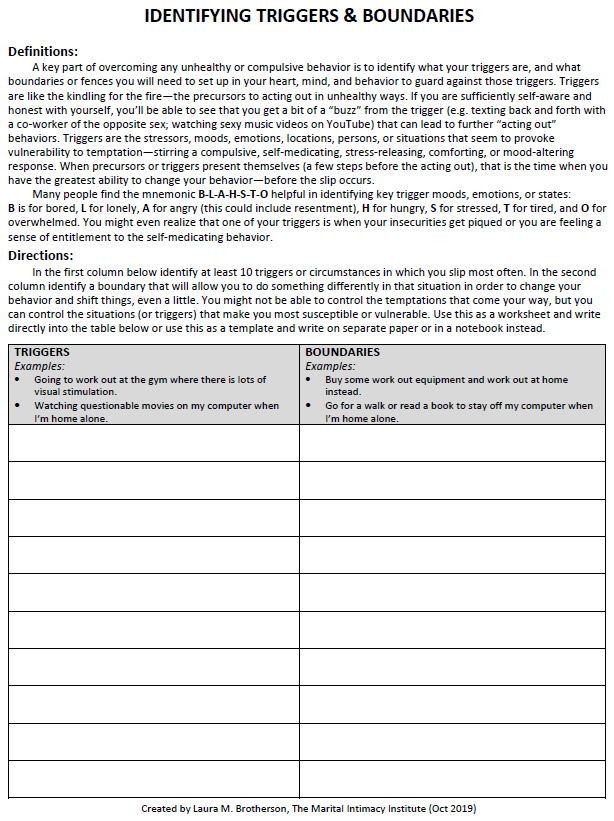 By doing these exercises regularly, you will learn to distinguish the voice of each of your states, as well as make decisions based on a reasonable idea of \u200b\u200bpersonal boundaries, which belongs to the Adult. However, this does not mean that the reactions of other states are of no value: everyone's voice is important, but the final decision should always remain with the Adult.
By doing these exercises regularly, you will learn to distinguish the voice of each of your states, as well as make decisions based on a reasonable idea of \u200b\u200bpersonal boundaries, which belongs to the Adult. However, this does not mean that the reactions of other states are of no value: everyone's voice is important, but the final decision should always remain with the Adult.
Get to know yourself
Take a diary, notebook or notepad and in a calm atmosphere remember what happened to you during the past week. When did you take time for yourself, take care of yourself, doing what you like? And vice versa: when did you reproach yourself for laziness, unproductiveness, mistakes? Write down your observations, but don't jump to conclusions right away.
The purpose of the exercise is to reflect, not to condemn, to understand when you really do what you want, and when you are too strict, because any work on yourself begins with understanding and acceptance.
Your personal boundaries
This exercise helps you to practice setting specific comfortable limits for your physical personal boundaries. To complete it, you will need an assistant, but this cannot be your friend or family member, because in relationships with loved ones, the boundaries are usually already defined long ago. With unfamiliar people, things are quite different.
Stand opposite each other at a comfortable distance (usually 1-2 meters is sufficient). When performing the exercise, you need to stay in place, while your friend will slowly reduce the distance. One step towards you every 30 seconds: the interval is needed so that you have time to evaluate your feelings.
Try to fix at what distance you started feeling slight discomfort. And when did you tighten up a little more? When did you want to run away, move away or push a person away? All these sensations are signals from your body, which is trying to warn against danger. Remember what distance is comfortable for you, and next time stop any attempts of people to invade your personal space.
Visualization of the border
The exercise will help you identify the borders, understand your attitude towards them and change it. To begin, close your eyes, imagine a limitless field and yourself, define your place in that space, and then build imaginary boundaries around it. How do they look? What material are they made of, are there doors, windows? Do you feel calm - or, on the contrary, feel anxiety, loneliness? If the borders in your mind are more of a negative connotation, try to think of them differently - for example, in the form of a beautiful hedge instead of barbed wire.
Now imagine your family, friends, colleagues and acquaintances and place them around you. Perhaps someone will be outside the borders, and someone will be right next to you. What do you feel now? Are you comfortable communicating with people outside your borders? Write down or draw what you feel.
Discussion table
Do you know situations when it is impossible to agree with yourself? One part cries capriciously: “I want to go to the sea”, another says: “Now is not the best time”, and the third is just waiting for all this to stop. The exercise will help to solve such situations, put everything in its place and come to terms with yourself.
Imagine that your three states—Child, Parent, and Adult—are sitting at a table with a problem in the center that needs to be solved. Each of your ego states reacts to this problem in its own way: the Child expresses emotions, the Parent judges whether he is doing the right thing or not, and the Adult, listening to everyone, makes the final decision. Think of any problem that bothered you last week and try to focus on it. What did you feel? How did they react? Maybe they forbade themselves something? How did you behave? Or how would you behave now, having sorted out the problem?
By answering these questions from different angles, you will let each of your "I" speak out, give them the right to be heard and be able to sensibly assess the situation, which means you will learn to adequately determine the boundaries of what is permissible.
Defining and defending personal boundaries
Sleep
In a state of chronic fatigue, people are prone to impulsive and reckless actions, and the voice of the Adult due to lack of sleep sounds as if from afar and cannot always be heard.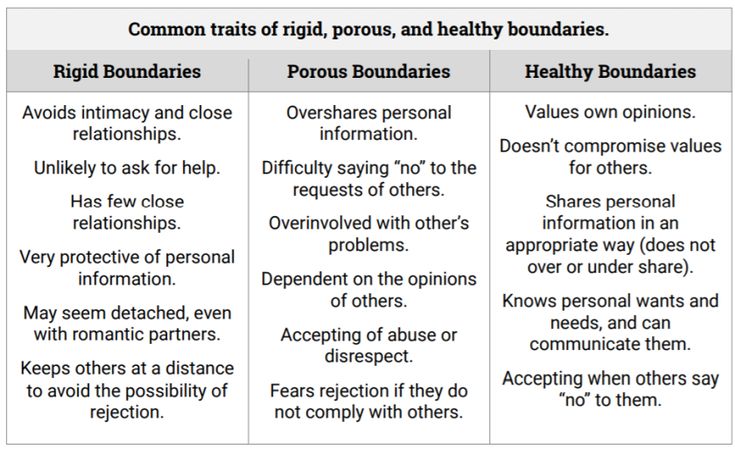 A person needs a healthy, sound and restful sleep. If already in the morning you feel tired, continue to experience stress, as if you had not rested, and your mood is below average, you need to make every possible effort to improve the situation.
A person needs a healthy, sound and restful sleep. If already in the morning you feel tired, continue to experience stress, as if you had not rested, and your mood is below average, you need to make every possible effort to improve the situation.
To normalize your sleep, make a plan of actions that you must complete before going to bed and stick to it. For example, at 21:00 - go to the shower, at 21:30 - start the dishwasher, at 22:00 - go to bed, at 22:30 - fall asleep.
Repeated activities will turn the process of falling asleep into a useful ritual, however, in addition to your personal plan, you need to create rules for others. For example, forbid children to enter your bedroom after 21:00. Create comfortable conditions for yourself first of all - at the same time practice in defending the boundaries (especially with loved ones, because, as practice shows, it is they who most often unknowingly violate personal comfort).
Sports
Some people tend to exhaust their body during sports, which leads to breakdowns, illnesses and emotional burnout.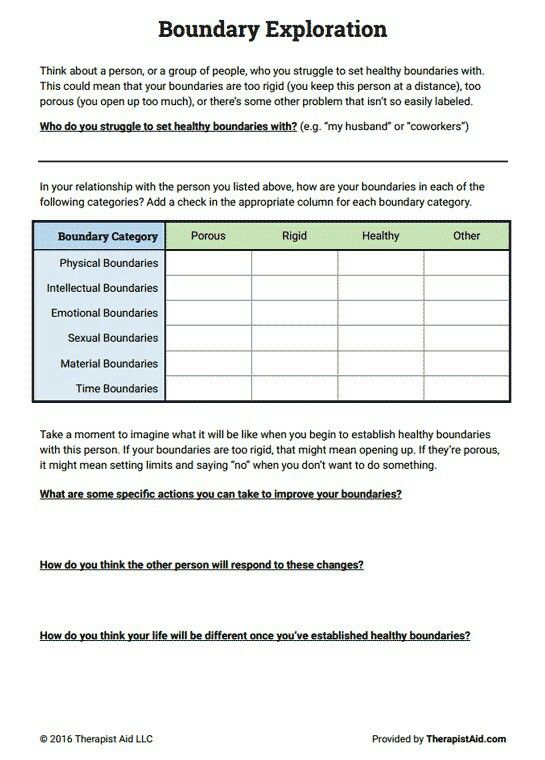 And all because, in addition to internal personal boundaries, people also have physical boundaries, which you also need to learn to feel in order to better understand when it is time to stop. Of course, regular sports are needed, they will help you better understand your body and feel its capabilities, but everything is good in moderation.
And all because, in addition to internal personal boundaries, people also have physical boundaries, which you also need to learn to feel in order to better understand when it is time to stop. Of course, regular sports are needed, they will help you better understand your body and feel its capabilities, but everything is good in moderation.
It is not necessary to exhaust yourself in an attempt to set world records - make a habit of light fitness or intense exercise in the morning, and this will be enough. Just remember, whatever you do, it's important to watch what your body is saying and help it. That is, give a rest if you are tired, or, conversely, load more if you feel a lack of activity or you need to relieve stress.
Bad habits
No matter what bad habits you have, you need to learn to set healthy personal boundaries around them. But be gradual, you don't have to give up everything at once. Slowly reduce the number of times you go into the habit until you feel you can do without it.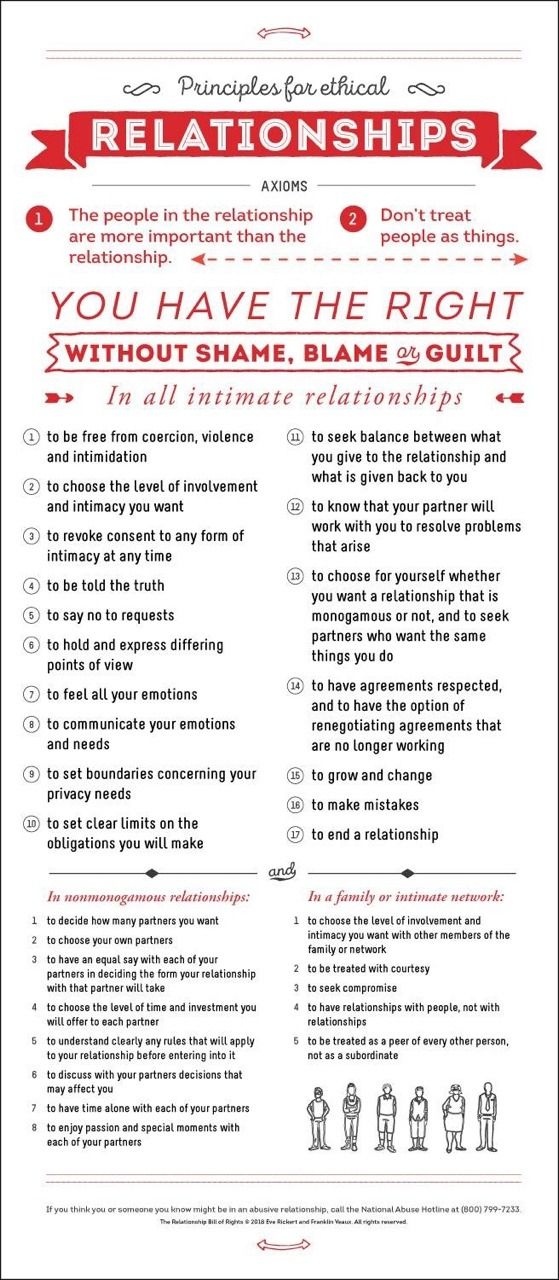 After all, it is you who should manage your habits, and not vice versa.
After all, it is you who should manage your habits, and not vice versa.
Remember that every time you give in, you are indulging one of your personalities, whose voice is now especially loud. So she tries to notify you that you are missing something very much. For example, the reason for cravings for alcohol may be the feeling of looseness and relaxation that a glass of wine gives. So wouldn’t it be better to just relax more often, instead of a glass of red wine, to devote time to yourself and your hobbies?
Communicating with people
In dealing with others, the easiest way to defend personal boundaries is when you feel them well and are confident in their benefits. But at first, of course, this is not easy to do. At first, you will have to regularly, time after time, carefully and politely inform (if appropriate) others about what you like and what you don’t. Most people, most likely, will not go where they will not be greeted hospitably - you will make this discovery as soon as you begin to clearly express your position and interests. Just do not forget that in any situation it is important to refrain from aggression and harsh reactions, so take all your ambiguous feelings and problems to the internal discussion table in order to make an informed decision before you start acting or reacting recklessly.
Just do not forget that in any situation it is important to refrain from aggression and harsh reactions, so take all your ambiguous feelings and problems to the internal discussion table in order to make an informed decision before you start acting or reacting recklessly.
Also, be prepared for the fact that, while defending personal boundaries, you are likely to stumble upon the dissatisfaction of some others. And that's not bad: what's the point of keeping a person nearby if he is not ready to respect your decisions and requests?
Social networks
Previously, communication between people took place mainly in real life, now - in social networks and instant messengers. However, despite this, the same communication norms and rules apply online. An unpleasant “bonus” is that, due to a certain level of understatement in social networks, the likelihood of offending or angering the interlocutor increases significantly. Therefore, it is definitely not worth underestimating the value of virtual communication and talking as if there is not a living person on the other side of the screen, but a faceless text.